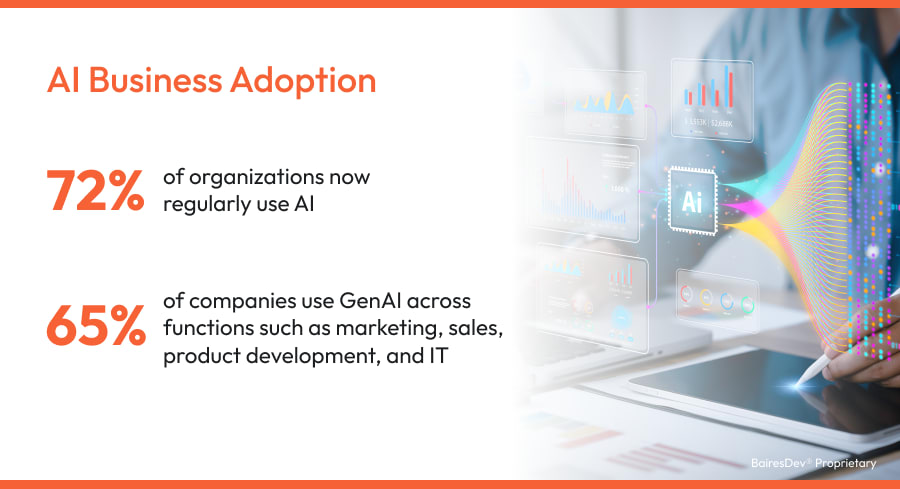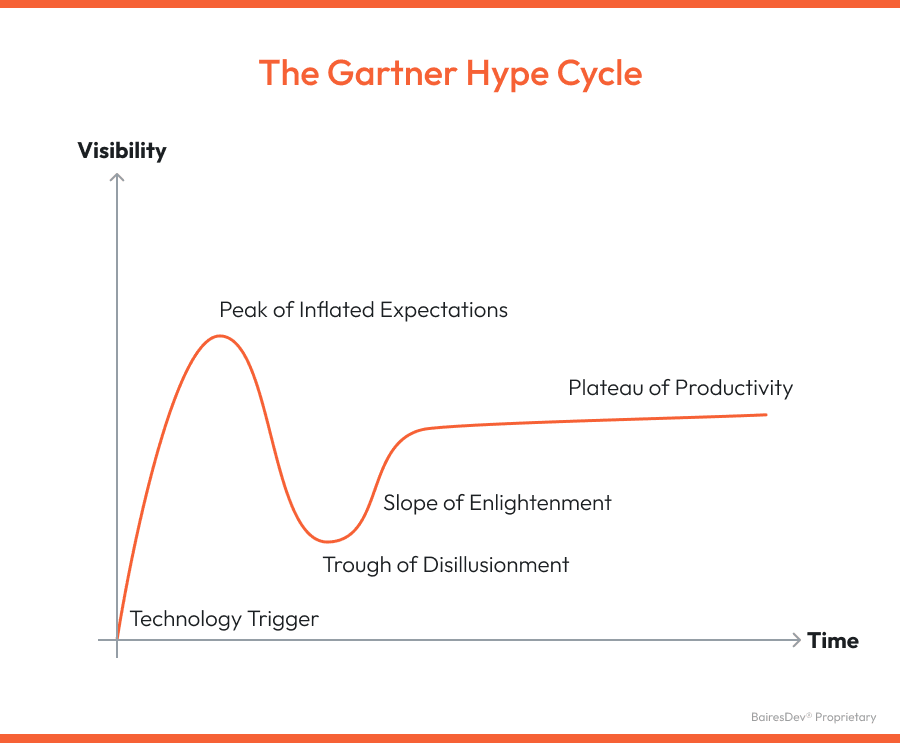Artificial Intelligence (AI) has become a transformative force across industries, reshaping how businesses operate without a doubt. A recent McKinsey report indicates that 72% of organizations now regularly use AI, up from 50% in the previous six years.
Fueling this growth is Generative AI (GenAI), now used by 65% of companies across functions such as marketing, sales, product development, and IT. This doubling in adoption within a year highlights AI’s increasing integration into daily life.
However, with these advantages come challenges. Organizations face issues like AI output inaccuracies that can skew decision-making, cybersecurity threats, and the complexities of explaining AI-driven decisions. The resulting excitement has also sparked an “AI-washing” phenomenon, where companies overstate AI capabilities, potentially misleading stakeholders and undermining trust in genuinely transformative AI solutions.
So, where do we stand with AI technology today? Where are we headed? And how can we manage our expectations around GenAI? There’s much to be excited about, but in a world of post-truths, it’s crucial to stay grounded and avoid getting swept up in hype cycles.
Tangible Positive Impacts of AI
Instead of getting caught up in promises and what’s just over the horizon, a better approach to understanding the scope of AI is to examine real use cases. What are we currently achieving with this technology? Here are some examples of how AI is being implemented in healthcare and finance:
Clinical Decision Support and Data Integration
TidalHealth Peninsula Regional faced a common challenge: clinicians were spending too much time searching for patient data which delayed care delivery. To address this issue, they partnered with IBM to implement IBM Micromedex with Watson AI, a cloud-based clinical decision support system.
This AI integration aggregated clinical information and used natural language processing (NLP) and machine learning to understand user queries, providing evidence-based recommendations directly within their electronic health records system. As a result, clinicians saved up to 20 minutes per encounter, improved adherence to best practices, and delivered more consistent patient care.
Data Aggregation and Analysis
Portal Telemedicina, a Brazilian healthcare platform faced challenges with fragmented care and inefficient systems. By partnering with Google Cloud, they harnessed AI for data aggregation, storage, and data analysis. Patient data was routed through a gateway to cloud storage, where AI algorithms classified medical findings and recommended treatment urgency—such as analyzing chest X-rays to detect pneumonia.
This implementation led to a 20% reduction in hospital admissions, a 5% decrease in healthcare costs, and improved patient outcomes due to more timely and accurate diagnoses.
Compliance Platforms and Operational Efficiency
PPS, an insurance company based in South Africa, enhanced its recommendation systems through an AI platform, resulting in increased sales growth. The AI facilitated personalized product recommendations, contributing to a 5% increase in sales within just eight weeks.
Hastings Direct, a UK-based insurance company, faced inefficiencies in underwriting and customer communication, which affected pricing accuracy and customer understanding. To tackle these issues, they implemented Azure-powered machine learning (ML) to streamline underwriting processes and enhance the readability of customer complaint letters.
This technology boosted their speed to market by over 100% and tripled the number of underwriting changes. Additionally, the readability score of complaint letters improved from 50 to 70, leading to clearer communication with customers.
A common thread among successful AI projects is their focus on specific problems and their reliance on proven solutions.

While the excitement of new innovations can be tempting, it’s essential to remain grounded in what has demonstrated effectiveness. The rush to launch new products often leads to a flurry of offerings, with many racing to be the first to market.
Our Experience With AI
In this context, our partnership with Pinterest exemplifies how leveraging established and reliable technologies can yield effective solutions.
We collaborated with Pinterest to enhance the performance of the Pinterest Ads Manager, leveraging its AI-powered Team Recommendation Engine to address the growing demand for IT talent. With over 400 million users visiting Pinterest each month, the platform faced the challenge of quickly sourcing highly skilled full-stack engineers in a competitive job market.
A client in the home renovation sector wanted to accelerate their process by using AI to enable homeowners to purchase windows, doors, and other renovation products from their phones. We built an AI-driven image cropping feature that allowed customers to take a picture of a house, isolate specified windows, and split them into different products within the app’s workflow. This innovation optimized the checkout speed, resulting in quicker transactions for customers by streamlining database queries.
Addressing Myths in AI
Are we going through an AI Winter?
“AI winter” refers to periods of notable decline in enthusiasm, funding, and progress. These downturns follow cycles of inflated expectations, where the potential of AI technologies is heavily promoted but ultimately disappoints when results fail to meet the hype. The first AI winter occurred from 1974 to 1980, primarily due to the influential Lighthill Report. This paper criticized ambitious AI claims and resulted in funding cuts from major institutions like DARPA.
During AI winters, research activity tends to drop as stakeholders pull back their investments, which can stall advancements. There’s an ongoing debate about whether these AI winters are genuinely “real” or just a sign of shifting public interest. Some critics think these downturns highlight deeper issues in AI’s tech framework, while others argue they simply reflect the ups and downs of mainstream attention.
When UBS chief strategist Bhane Baweja asked his analysts about any notable changes in their cost or revenue projections due to AI, their response was mostly shoulder shrugs. In his view, this indicates that the shift toward AI is more of an evolution than a revolution. Another sign of a perceived AI winter is the recent plunge in Nvidia’s stock. After a period of unprecedented growth, its performance is now falling short of market expectations—so much so that its valuation dropped by US$279 billion in a single day.
So, are we really in an AI winter? The short answer is no. While companies and investors may have had inflated expectations, this is often due to a lack of understanding about AI’s actual capabilities and limitations. This poor understanding might have then caused an AI overhype.
The AI Hype
To grasp what tech hype really means, let’s take a look at the Gartner Hype Cycle. This graphical representation helps us navigate the maturity and adoption of emerging technologies. It illustrates how a technology progresses through five distinct phases: the Innovation Trigger, Peak of Inflated Expectations, Trough of Disillusionment, Slope of Enlightenment, and Plateau of Productivity.
Each phase illustrates how public interest evolves. It starts with initial excitement, peaking with inflated expectations, and often leading to disillusionment when early implementations may fail. The cycle ends with a more realistic assessment of the technology’s capabilities and its potential to solve business problems. This progression offers valuable insights for decision-makers about aligning technology deployment with their business goals.
Is AI caught up in a hype cycle? Absolutely. The aforementioned AI-washing is just one example of companies jumping on the AI bandwagon and making lofty promises. Frankly, it’s not surprising. An innovation with such potential to transform our relationship with technology dazzled us with the launch of ChatGPT just a couple of years ago. We definitely got a bit too excited.
To set realistic expectations, we need to take the time to learn about this technology. This way, we can be more conscious of what to expect.
Setting Realistic Expectations
To avoid the pitfalls of hype cycles, it’s crucial to take a proactive approach to understanding new technologies. Leaders and stakeholders should educate themselves about the emerging technology’s promise within the context of their specific industry, balancing risk assessment with potential rewards.
Companies have different strategies to consider. They can take early risks to become pioneers in their market or adopt a moderate approach with cautious investments and thorough cost-benefit analyses. Another option is to wait until the technology matures and is verified through real-world applications before making a commitment.
Focus on Small Implementations
The hype cycle can inflate expectations, pushing organizations toward ambitious AI projects that may not meet their immediate needs. By focusing on specific problems, organizations can ensure their AI initiatives address real challenges and deliver tangible results.
Starting with small implementations helps teams allocate resources effectively and reduce risks. This approach maintains clarity and direction, enabling efficient decision-making and prompt adjustments. By concentrating on core objectives, organizations can avoid overextension and keep their AI projects aligned with their strategic vision.

Build Trust in AI
Building trust in AI is crucial for getting everyone on board. Organizations should ensure their AI outputs are fair, accurate, and easy to understand. Key factors include knowing who trains the AI, the quality of the data, and what influences its recommendations.
Transparency is essential. Stakeholders need to understand how AI makes decisions and the data journey involved. Protecting data throughout the AI lifecycle helps prevent biases and strengthens trust.
Starting small with a clear vision and early wins helps build trustworthy AI, laying the groundwork for greater innovations. As models demonstrate their value, trust deepens, allowing businesses to confidently scale their AI initiatives.
Build Your AI Solution Now
Artificial Intelligence is transforming industries, processes, and our expectations for technology. While AI brings real benefits like improved efficiency and innovation, it’s crucial to recognize the myths and limitations that come with its rapid growth.
Overhyping AI can create unrealistic expectations and erode trust. By focusing on small, manageable implementations and emphasizing transparency and ethical considerations, organizations can build trust and set the stage for bigger innovations.
We encourage you to embrace AI with an informed and optimistic outlook, acknowledging its potential while being aware of its challenges. Reach out to us so we can collaborate on building robust AI solutions for your business.









